The global industrial enzymes market is likely to grow from USD 7.9 billion in 2025 to approximately USD 14.4 billion by 2035, recording an absolute increase of USD 6.5 billion over the forecast period. This translates into a total growth of 82.3%, with the market forecast to expand at a compound annual growth rate (CAGR) of 6.2% between 2025 and 2035. The market size is expected to grow by nearly 1.82X during the same period, supported by increasing demand for manufacturing processes, rising adoption in food and beverage applications, and increasing focus on eco-friendly production methods across various industrial sectors.
Between 2025 and 2030, the industrial enzymes market is projected to expand from USD 7.9 billion to USD 10.8 billion, resulting in a value increase of USD 2.9 billion, which represents 44.6% of the total forecast growth for the decade. This phase of development will be shaped by rising demand for production processes, increasing adoption of enzyme-based solutions in manufacturing, and growing penetration of industrial enzymes in emerging applications. Biotechnology companies are expanding their enzyme product portfolios to address the growing demand for environmentally friendly industrial solutions.
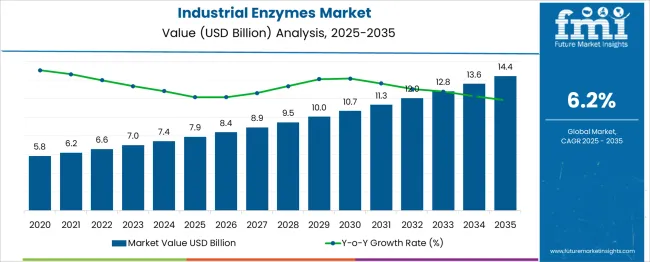
| Metric | Value |
|---|---|
| Estimated Value in (2025E) | USD 7.9 billion |
| Forecast Value in (2035F) | USD 14.4 billion |
| Forecast CAGR (2025 to 2035) | 6.2% |
From 2030 to 2035, the market is forecast to grow from USD 10.8 billion to USD 14.4 billion, adding another USD 3.6 billion, which constitutes 55.4% of the ten-year expansion. This period is expected to be characterized by the expansion of biotechnology applications, the integration of advanced enzyme production technologies, and the development of specialized enzyme solutions for niche applications. The growing adoption of circular economy principles and manufacturing practices will drive demand for industrial enzymes with enhanced performance characteristics and environmental benefits.
Between 2020 and 2025, the industrial enzymes market experienced steady expansion, driven by increasing focus on manufacturing and growing awareness of enzyme benefits in industrial processes. The market developed as manufacturers recognized the need for eco-friendly alternatives to traditional chemical processes. Environmental regulations and initiatives began emphasizing the importance of enzyme-based solutions in reducing industrial ecological impact and improving process efficiency.
Market expansion is being supported by the increasing demand for environmentally friendly manufacturing processes across various industrial sectors. Modern manufacturers are increasingly focused on reducing their environmental footprint while maintaining production efficiency and product quality. Industrial enzymes' proven ability to enhance process efficiency, reduce energy consumption, and minimize waste generation makes them a preferred choice in manufacturing applications.
The growing focus on biotechnology and green chemistry is driving demand for enzyme-based solutions that can replace traditional chemical processes. Manufacturer preference for cost-effective solutions that combine environmental benefits with operational efficiency is creating opportunities for innovative enzyme applications. The rising influence of regulatory requirements for manufacturing and environmental protection is also contributing to increased adoption of industrial enzymes across different industries and geographic regions.
The market is segmented by product, source, application, and region. By product, the market is divided into proteases, carbohydrases, lipases, polymerases & nucleases, and other products. Based on the source, the market is categorized into microorganisms, plants, and animals. In terms of application, the market is segmented into food & beverage, detergents, animal feed, biofuels, textiles, pulps & papers, and other applications. Regionally, the market is divided into North America, Europe, East Asia, South Asia & Pacific, Latin America, and the Middle East & Africa.
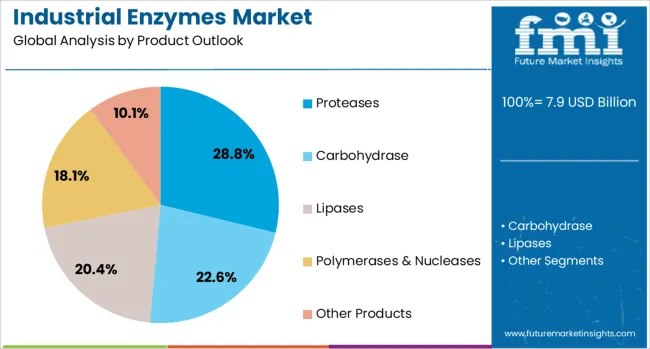
The proteases segment is projected to account for 28.8% of the industrial enzymes market in 2025, reaffirming its position as the leading product category. Consumers and manufacturers increasingly prefer proteases for their versatility in breaking down proteins and their wide application across food processing, detergent manufacturing, and textile processing industries. Proteases' well-documented effectiveness in improving process efficiency and product quality directly addresses industrial demands for reliable and high-performance enzyme solutions.
This product category forms the foundation of most enzyme applications, as it represents the most widely used and commercially viable enzyme type across multiple industries. Manufacturer investments in protease development and ongoing research into enhanced formulations continue to strengthen market adoption. With industrial users prioritizing process optimization and cost efficiency, proteases align with both performance requirements and economic considerations, making them the central growth driver of industrial enzyme demand.
Micro-organisms are projected to represent 75.4% of industrial enzyme demand in 2025, underscoring their critical role as the primary source for enzyme production. Manufacturers prefer micro-organism-derived enzymes for their scalability, consistency, and ability to produce high-quality enzymes through controlled fermentation processes. Positioned as the most reliable and cost-effective source, micro-organism-based production offers both economic advantages and technical performance benefits for large-scale enzyme manufacturing.
The segment is supported by advances in biotechnology and fermentation technology that enable efficient enzyme production at commercial scales. Manufacturers are increasingly utilizing genetically modified microorganisms to produce specialized enzymes with enhanced properties and performance characteristics. As industrial users prioritize supply chain reliability and product consistency, micro-organism-derived enzymes will continue to dominate the market while supporting scalable enzyme production.
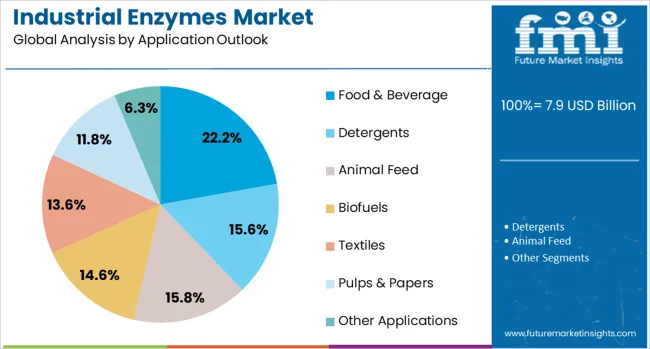
The food & beverage application is forecasted to contribute 22.2% of the industrial enzymes market in 2025, expanding the critical importance of enzymes in food processing and manufacturing. Consumers are increasingly demanding natural and clean-label food products, preferring enzyme-based processing methods that maintain product quality while avoiding synthetic additives. This aligns with the clean-label movement, which emphasizes natural ingredients and environmentally responsible production methods.
The segment benefits from continuous innovation in food processing technology and consumer willingness to pay premium prices for naturally processed foods that combine quality with health benefits. With heightened regulatory oversight and rising awareness of food safety and quality, enzyme-based food processing serves as a powerful differentiator, making it a critical driver of trust and market growth in the industrial enzymes category.
The industrial enzymes market is advancing steadily due to increasing focus on manufacturing practices and growing demand for environmentally-friendly industrial solutions. The market faces challenges, including high development costs, regulatory compliance requirements, and competition from traditional chemical processes. Innovation in enzyme engineering and biotechnology continues to influence product development and market expansion patterns.
The growing adoption of biotechnology solutions is enabling manufacturers to develop more efficient production processes. Enzyme-based manufacturing offers environmental benefits, reduced energy consumption, and improved process efficiency compared to traditional chemical methods. Industrial users are increasingly recognizing the long-term economic and ecological advantages of enzyme-based solutions.
Modern enzyme manufacturers are incorporating advanced genetic engineering, protein design, and fermentation technologies to develop enhanced enzyme products with improved stability and performance characteristics. These technologies improve enzyme effectiveness while extending product shelf life and providing better industrial application results. Advanced production techniques also enable customized enzyme solutions that deliver specific performance benefits for targeted applications.

| Countries | CAGR (2025-2035) |
|---|---|
| China | 8.4% |
| India | 7.8% |
| Germany | 7.1% |
| France | 6.5% |
| UK | 5.9% |
| USA | 5.3% |
| Brazil | 4.7% |
The industrial enzymes market is experiencing solid growth globally, with China leading at an 8.4% CAGR through 2035, driven by rapid industrialization, the expanding biotechnology sector, and increasing focus on manufacturing practices. India follows closely at 7.8%, supported by growing pharmaceutical and food processing industries, increasing biotechnology investments, and expanding industrial enzyme applications. Germany shows strong growth at 7.1%, emphasizing advanced manufacturing and production solutions. France records 6.5%, focusing on food and beverage applications and biotechnology innovation. The UK shows 5.9% growth, prioritizing manufacturing and industrial efficiency.
The report covers an in-depth analysis of 40+ countries; seven top-performing countries are highlighted below.
Revenue from industrial enzymes in China is projected to exhibit strong growth with a CAGR of 8.4% through 2035, driven by rapid industrial development and increasing adoption of manufacturing practices. The country's expanding biotechnology sector and growing focus on environmental compliance are creating significant demand for enzyme-based industrial solutions. Major domestic and international enzyme manufacturers are establishing comprehensive production facilities to serve both domestic industrial users and export markets.
Revenue from industrial enzymes in India is expanding at a CAGR of 7.8%, supported by rapidly growing pharmaceutical, food processing, and textile industries, along with increasing government support for biotechnology development. The country's expanding manufacturing sector and rising focus on production methods are driving demand for high-quality enzyme solutions. International biotechnology companies and domestic manufacturers are establishing distribution networks to serve the growing demand for industrial enzyme applications.
Demand for industrial enzymes in Germany is estimated to grow at a CAGR of 7.1%, supported by the country's leadership in advanced manufacturing and strong focus on production technologies. German manufacturers are increasingly focused on process efficiency, environmental compliance, and technological innovation. The market is characterized by strong demand for specialized enzymes in chemical processing, food manufacturing, and advanced materials production.
Revenue from industrial enzymes in France is projected to grow at a CAGR of 6.5% through 2035, driven by the country's strong food and beverage industry and focus on biotechnology innovation. French manufacturers consistently demand high-quality enzyme solutions that deliver superior performance while maintaining product safety and regulatory compliance.
Revenue from industrial enzymes in the UK is projected to grow at a CAGR of 5.9% through 2035, supported by a strong focus on manufacturing practices and industrial efficiency improvements. British manufacturers value environmental compliance, process optimization, and proven performance, positioning industrial enzymes as essential components of modern manufacturing operations.
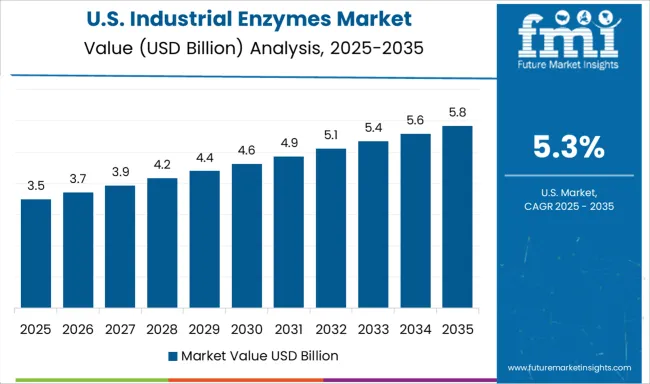
Revenue from industrial enzymes in the USA is projected to grow at a CAGR of 5.3% through 2035, supported by the country's leadership in biotechnology innovation, advanced manufacturing capabilities, and preference for high-performance enzyme solutions. American manufacturers prioritize process efficiency, regulatory compliance, and technological advancement, making industrial enzymes a preferred choice in advanced manufacturing applications.
Revenue from industrial enzymes in Brazil is projected to grow at a CAGR of 4.7% through 2035, supported by expanding industrial manufacturing, the growing food processing sector, and increasing adoption of production technologies. The country's large agricultural and food processing industries are creating significant opportunities for enzyme applications. International biotechnology companies and domestic manufacturers are establishing production and distribution networks to serve the growing demand for industrial enzyme solutions.
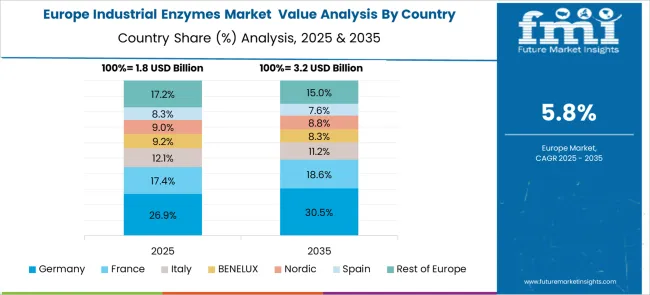
The industrial enzymes market in Europe demonstrates mature development across major economies, with Germany showing a strong presence through its advanced manufacturing sector and focus on production technologies, supported by companies leveraging biotechnology expertise to develop high-performance enzyme solutions for industrial applications that emphasize efficiency and environmental responsibility.
France represents a significant market driven by its food and beverage industry heritage and sophisticated understanding of enzyme applications, with companies focusing on premium enzyme solutions that combine French innovation with advanced biotechnology for enhanced manufacturing processes and product quality benefits in food processing and industrial applications.
The UK exhibits considerable growth through its embrace of manufacturing practices and biotechnology innovation, with strong adoption of industrial enzymes in detergent manufacturing, food processing, and emerging applications. Germany and France show expanding interest in advanced enzyme applications, particularly in specialty chemicals and biotechnology sectors. BENELUX countries contribute through their focus on manufacturing and environmental compliance. At the same time, Eastern Europe and the Nordic regions display growing potential driven by increasing industrial enzyme adoption and expanding access to biotechnology solutions across diverse manufacturing sectors.
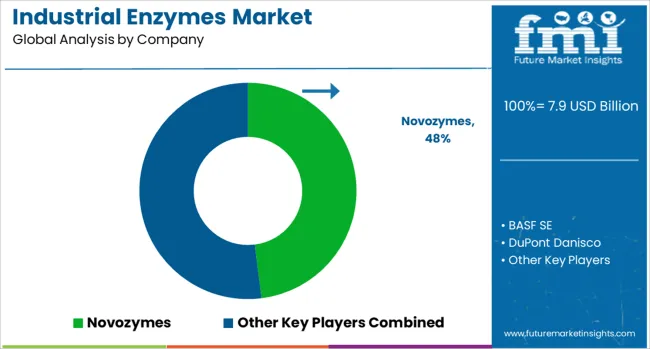
The industrial enzymes market is characterized by competition among established biotechnology companies, specialty enzyme manufacturers, and emerging biotech players. Companies are investing in advanced enzyme engineering, research and development, production capacity expansion, and strategic partnerships to deliver high-performance, reliable, and cost-effective enzyme solutions. Product innovation, manufacturing efficiency, and application expertise are central to strengthening product portfolios and competitive advantages.
Novozymes leads the market with a significant global market share, offering comprehensive enzyme solutions with a focus on industrial application expertise. BASF SE provides advanced enzyme technologies with focus on chemical industry applications and manufacturing excellence. DuPont Danisco delivers specialized enzyme solutions with a focus on food processing and industrial biotechnology. DSM focuses on nutritional and industrial enzyme applications with a focus on health and benefits.
NOVUS INTERNATIONAL provides animal nutrition and feed additive enzymes with a focus on agricultural applications and animal health benefits. Associated British Foods Plc offers comprehensive enzyme solutions across food processing and industrial applications. Amano Enzyme Inc. specializes in pharmaceutical and industrial enzyme applications with a focus on high-purity and specialized products. Chr. Hansen Holding A/S delivers enzyme solutions for food processing with a focus on natural ingredients and fermentation technologies. Advanced Enzyme Technologies, Lesaffre, Adisseo, and Enzyme Development Corporation provide specialized enzyme solutions with a focus on specific industrial applications and niche markets.
| Items | Values |
|---|---|
| Quantitative Units (2025) | USD 7.9 billion |
| Product | Proteases, Carbohydrases, Lipases, Polymerases & Nucleases, Other Products |
| Source | Micro-Organisms, Plants, Animals |
| Application | Food & Beverage, Detergents, Animal Feed, Biofuels, Textiles, Pulps & Papers, Other Applications |
| Regions Covered | North America, Europe, East Asia, South Asia & Pacific, Latin America, Middle East & Africa |
| Countries Covered | United States, Canada, United Kingdom, Germany, France, China, Japan, South Korea, India, Brazil, Australia, and 40+ countries |
| Key Companies Profiled | Novozymes, BASF SE, DuPont Danisco, DSM, NOVUS INTERNATIONAL, Associated British Foods Plc, Amano Enzyme Inc., Chr. Hansen Holding A/S, Advanced Enzyme Technologies, Lesaffre, Adisseo, and Enzyme Development Corporation (EDC) |
| Additional Attributes | Dollar sales by enzyme type and application category, regional demand trends, competitive landscape, buyer preferences for microbial versus plant-based sources, integration with manufacturing practices, innovations in enzyme engineering, biotechnology advancement, and emerging application development |
North America
Europe
East Asia
South Asia & Pacific
Latin America
Middle East & Africa
The global industrial enzymes market is estimated to be valued at USD 7.9 billion in 2025.
The market size for the industrial enzymes market is projected to reach USD 14.4 billion by 2035.
The industrial enzymes market is expected to grow at a 6.2% CAGR between 2025 and 2035.
The key product types in industrial enzymes market are proteases, carbohydrase, lipases, polymerases & nucleases and other products.
In terms of source outlook , micro-organisms segment to command 75.4% share in the industrial enzymes market in 2025.






Our Research Products

The "Full Research Suite" delivers actionable market intel, deep dives on markets or technologies, so clients act faster, cut risk, and unlock growth.

The Leaderboard benchmarks and ranks top vendors, classifying them as Established Leaders, Leading Challengers, or Disruptors & Challengers.

Locates where complements amplify value and substitutes erode it, forecasting net impact by horizon

We deliver granular, decision-grade intel: market sizing, 5-year forecasts, pricing, adoption, usage, revenue, and operational KPIs—plus competitor tracking, regulation, and value chains—across 60 countries broadly.

Spot the shifts before they hit your P&L. We track inflection points, adoption curves, pricing moves, and ecosystem plays to show where demand is heading, why it is changing, and what to do next across high-growth markets and disruptive tech

Real-time reads of user behavior. We track shifting priorities, perceptions of today’s and next-gen services, and provider experience, then pace how fast tech moves from trial to adoption, blending buyer, consumer, and channel inputs with social signals (#WhySwitch, #UX).

Partner with our analyst team to build a custom report designed around your business priorities. From analysing market trends to assessing competitors or crafting bespoke datasets, we tailor insights to your needs.
Supplier Intelligence
Discovery & Profiling
Capacity & Footprint
Performance & Risk
Compliance & Governance
Commercial Readiness
Who Supplies Whom
Scorecards & Shortlists
Playbooks & Docs
Category Intelligence
Definition & Scope
Demand & Use Cases
Cost Drivers
Market Structure
Supply Chain Map
Trade & Policy
Operating Norms
Deliverables
Buyer Intelligence
Account Basics
Spend & Scope
Procurement Model
Vendor Requirements
Terms & Policies
Entry Strategy
Pain Points & Triggers
Outputs
Pricing Analysis
Benchmarks
Trends
Should-Cost
Indexation
Landed Cost
Commercial Terms
Deliverables
Brand Analysis
Positioning & Value Prop
Share & Presence
Customer Evidence
Go-to-Market
Digital & Reputation
Compliance & Trust
KPIs & Gaps
Outputs
Full Research Suite comprises of:
Market outlook & trends analysis
Interviews & case studies
Strategic recommendations
Vendor profiles & capabilities analysis
5-year forecasts
8 regions and 60+ country-level data splits
Market segment data splits
12 months of continuous data updates
DELIVERED AS:
PDF EXCEL ONLINE
Industrial Bench Scale Market Size and Share Forecast Outlook 2025 to 2035
Industrial Low Profile Floor Scale Market Size and Share Forecast Outlook 2025 to 2035
Industrial Sand Mill Market Size and Share Forecast Outlook 2025 to 2035
Industrial Control Network Modules Market Size and Share Forecast Outlook 2025 to 2035
Industrial Precision Oven Market Size and Share Forecast Outlook 2025 to 2035
Industrial Water Chiller for PCB Market Size and Share Forecast Outlook 2025 to 2035
Industrial & Commercial HVLS Fans Market Size and Share Forecast Outlook 2025 to 2035
Industrial Robot Controller Market Size and Share Forecast Outlook 2025 to 2035
Industrial Wired Routers Market Size and Share Forecast Outlook 2025 to 2035
Industrial Evaporative Condensers Market Size and Share Forecast Outlook 2025 to 2035
Industrial Energy Management System Market Size and Share Forecast Outlook 2025 to 2035
Industrial Insulation Market Size and Share Forecast Outlook 2025 to 2035
Industrial Safety Gloves Market Size and Share Forecast Outlook 2025 to 2035
Industrial Cleaner Market Size and Share Forecast Outlook 2025 to 2035
Industrial Dust Treatment System Market Size and Share Forecast Outlook 2025 to 2035
Industrial Vertical Washing Tower Market Size and Share Forecast Outlook 2025 to 2035
Industrial Pepper Market Size and Share Forecast Outlook 2025 to 2035
Industrial Electronics Packaging Market Forecast and Outlook 2025 to 2035
Industrial Absorbent Market Forecast and Outlook 2025 to 2035
Industrial Furnace Industry Analysis in Europe Forecast and Outlook 2025 to 2035

Thank you!
You will receive an email from our Business Development Manager. Please be sure to check your SPAM/JUNK folder too.
Chat With
MaRIA